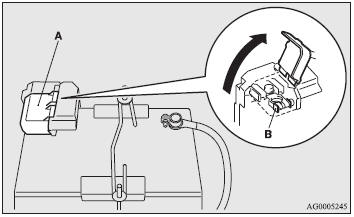 Mitsubishi Outlander: Battery
Mitsubishi Outlander: Battery
The condition of the battery is very important for quick starting and to keep the vehicle’s electrical system working properly. Regular inspection and care are especially important in cold weather.
NOTE:
● Memory data for settings made by the user may be erased when the battery is replaced.
If this happens, establish the settings again using the relevant procedures.
Checking battery electrolyte level

The electrolyte level must be between the specified limit on the outside of the battery. Replenish with distilled water as necessary. The inside of the battery is divided into several compartments; remove the cap from each compartment and fill to the upper mark. Do not top up beyond the upper mark because spillage during driving could cause damage. Check the electrolyte level at least once every four weeks, depending on the operating conditions. If the battery is not used, it will discharge by itself with time. Check it once every four weeks and charge with low current as necessary.
During cold weather
The capacity of the battery is reduced at low temperatures. This is an inevitable result of its chemical and physical properties. This is why a very cold battery, particularly one that is not fully charged will only deliver a fraction of the starter current which is normally available. We recommend you to have the battery checked before the start of cold weather and, if necessary, have it charged or replaced. This does not only ensures reliable starting, but a battery which is kept fully charged also has a longer life.
Disconnection and connection

To disconnect the battery cable, stop the engine, first disconnect the negative (-) terminal and then the positive (+) terminal. When connecting the battery, first connect the positive (+) terminal and then the negative (-) terminal.
NOTE:
● Open the terminal cover (A) before disconnecting or connecting the positive (+)
terminal of the battery.
● Loosen the nut (B), and then disconnect the battery cable from the positive (+)
terminal.
WARNING:
● Keep sparks, cigarettes, and flames away from the battery because the battery
could explode.
● The battery electrolyte is extremely caustic. Do not allow it to come in contact
with your eyes, skin, clothing, or the painted surfaces of the vehicle. Spilt electrolyte
should be flushed immediately with ample amounts of water. Irritation to eyes or
skin from contact with electrolyte requires immediate medical attention.
● Ventilate when charging or using the battery in an enclosed space.
CAUTION:
● Keep it out of reach of children.
● Never disconnect the battery when the ignition switch is in the “ON” position.
Doing so could damage electric components.
● Never short-circuit the battery. This could cause it to overheat and be damaged.
● If the battery is to be quickcharged, first disconnect the battery cables.
● In order to prevent a short circuit, be sure to disconnect the negative (-) terminal
first.
● Always wear protective eye goggles when working near the battery.
● Do not bring the nearby parts, the plastic parts and so on into contact with sulphuric
acid (battery electrolyte) which may crack, stain or discolour them. If they are
in contact, wipe off with soft cloth, chamois or the like and an aqueous solution
of neutral detergent then immediately rinse the affected parts with plenty of water.
NOTE:
● Keep the terminals clean. After the battery is connected, apply terminal protection
grease. To clean the terminals, use lukewarm water.
● Check to see if the battery is securely installed and cannot be moved during travel.
Also check each terminal for tightness.
● When the vehicle is to be left unused for a long period of time, remove the battery
and store it in a place where the battery fluid will not freeze. The battery should
be stored only in a fully charged condition.
 Power steering fluid
Power steering fluid
To check the fluid level
Check the fluid level in the reservoir while the engine is idling. Check to make
certain that the power steering fluid level is always between the “MAX” and “MIN” ...
 Tyres
Tyres
WARNING:
● Driving with tyres that are worn or improperly inflated can result in a collision
and serious or fatal injury.
Tyre inflation pressures
*: Above 160 km/h (100 mph).
Check the ...
See also:
A/T Selector Position Indicator (if equipped)
A/T Selector
Position Indicator (if equipped)
When the ignition switch is in the “ON” position, this indicator shows the selector
position of automatic transmission. ...
Recommended grade and viscosity
Each oil manufacturer has its own base
oils and additives. Never use different
brands together. For details, refer to
“Manual transmission, front differential
and rear differential gear oilâ ...
Wheel Replacement
Replace any wheel that is bent, cracked, or badly rusted or corroded. If wheel
nuts keep coming loose, the wheel, wheel bolts, and wheel nuts should be replaced.
If the wheel leaks air, replace it ...
